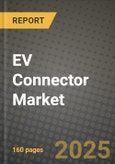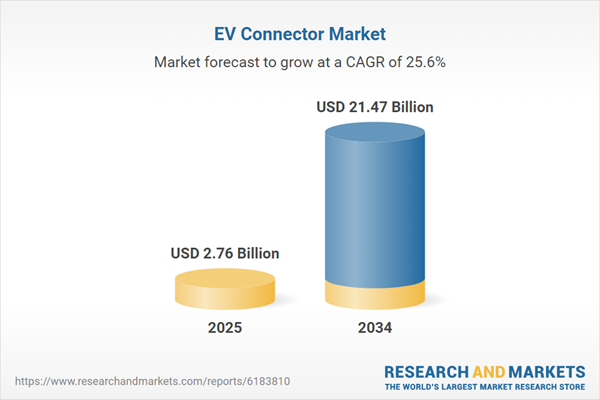EV Connector Market
The EV Connector Market is at the heart of electrified mobility, translating grid and storage energy into safe, repeatable charging events across vehicles, depots, and public networks. The market spans vehicle inlets, charging plugs, cables, couplers, liquid-cooled assemblies for high power, communication pins, and smart locking mechanisms - plus back-shells, strain reliefs, and sealing systems tuned for outdoor durability. Top applications include home AC charging, workplace and destination AC, public DC fast charging, heavy-duty depot charging for buses and trucks, and burgeoning megawatt-class systems for long-haul logistics. Latest trends emphasize thermal management for sustained high current, ruggedized designs for high-cycle urban sites, contact materials engineered for lower resistance and arcing control, and cybersecurity/handshake protocols embedded in the connector ecosystem. Growth is propelled by EV adoption curves, fleet electrification mandates, charge-point expansion, and standardization roadmaps that reduce complexity and unlock cross-border interoperability. The competitive landscape blends connector specialists, cable makers, Tier-1 charging hardware firms, and vehicle OEMs co-developing inlet/plug interfaces to balance ergonomics, reliability, and cost. Design priorities center on safety (touch protection, temperature sensing, ground continuity), user experience (grip geometry, weight, holster fit), and uptime (field-serviceability, replaceable wear components). As charging moves from pilots to industrialized networks, winners align connector platforms with evolving standards, liquid-cooling readiness, automated handling for robotics, and robust supply resilience across metals, polymers, and electronics.EV Connector Market Key Insights
- Standards convergence as a market accelerator
- Thermal management defines high-power viability
- Ruggedization for real-world duty cycles
- User-centric ergonomics reduce failure and friction
- Data and diagnostics embedded at the edge
- Materials engineering for safety and longevity
- Heavy-duty and depot electrification reshape specs
- Automation and robotics enter the loop
- Cybersecure handshakes and payments by design
- Supply chain resilience becomes strategic
EV Connector Market Reginal Analysis
North America
Network build-out accelerates across highways, urban hubs, and fleets, driving demand for high-power, liquid-cooled connectors and NACS/CCS interoperability. Operators prize ruggedized plugs with replaceable wear parts, standardized diagnostics, and holster systems that protect faces from drops. Depot electrification for buses and trucks lifts requirements for ergonomic, high-cycle connectors and cable management, while regionalized assembly and component dual-sourcing de-risk supply.Europe
Mature corridor coverage shifts focus to uptime, serviceability, and cross-border interoperability under stringent safety and environmental standards. High adoption of public DC fast charging and destination AC favors connectors with robust weather sealing, cold-climate performance, and consistent latch feel. Fleet depots and heavy-duty pilots push interest in automated couplers and liquid-cooled assemblies, with recyclability and material disclosures influencing procurement.Asia-Pacific
Scale in passenger EVs and two/three-wheelers drives connector variety, while national standards and rapid site deployment demand cost-optimized, high-throughput designs. China’s ecosystem advances high-power liquid-cooled solutions and heavy-duty interfaces, Japan and Korea emphasize precision manufacturing and reliability, and India prioritizes rugged AC/DC connectors for challenging environments. Local supply chains and fast certification cycles enable rapid product iteration.Middle East Africa
Hot-climate operation shapes connector specifications around thermal stability, UV resistance, and sand ingress protection. Tourism and premium EV imports seed fast-charging hubs, while commercial fleets in ports and logistics corridors spur demand for durable, easy-service plugs and cable booms. Utility-operator collaborations favor standardized diagnostics and connectors that minimize derating during extreme ambient temperatures.
South & Central America
Urbanization and ride-hail electrification concentrate demand in metropolitan clusters, with emphasis on robust AC connectors for residential/commercial installs and scalable DC solutions at retail and fleet sites. Procurement favors cost-effective, serviceable designs with clear spares programs and training support. Operators value multi-standard compatibility to accommodate mixed vehicle imports and evolving national guidelines.EV Connector Market Segmentation
By System
- Sealed Connector System
- Unsealed Connector System
By Propulsion
- BEV
- PHEV
- FCEV
- HEV
By Connection
- Wire-to-Wire Connection
- Wire-to-Board Connection
- Board-to-Board Connection
- Others
By Application
- ADAS and Safety System
- Body Control and Interiors
- Engine Management and Powertrain
- Infotainment System
- Battery Management System
- Vehicle Lighting
- Others
By Voltage
- Low Voltage
- Medium Voltage
- High Voltage
By Component
- Terminal
- Housing
- Lock
- Others
Key Market players
TE Connectivity, Yazaki Corporation, Sumitomo Electric, JAE (Japan Aviation Electronics), Amphenol, Aptiv, Molex, Huber+Suhner, Rosenberger, Phoenix Contact, ITT Cannon, HARTING, MENNEKES, REMA, StäubliEV Connector Market Analytics
The report employs rigorous tools, including Porter’s Five Forces, value chain mapping, and scenario-based modelling, to assess supply-demand dynamics. Cross-sector influences from parent, derived, and substitute markets are evaluated to identify risks and opportunities. Trade and pricing analytics provide an up-to-date view of international flows, including leading exporters, importers, and regional price trends.Macroeconomic indicators, policy frameworks such as carbon pricing and energy security strategies, and evolving consumer behaviour are considered in forecasting scenarios. Recent deal flows, partnerships, and technology innovations are incorporated to assess their impact on future market performance.
EV Connector Market Competitive Intelligence
The competitive landscape is mapped through proprietary frameworks, profiling leading companies with details on business models, product portfolios, financial performance, and strategic initiatives. Key developments such as mergers & acquisitions, technology collaborations, investment inflows, and regional expansions are analyzed for their competitive impact. The report also identifies emerging players and innovative startups contributing to market disruption.Regional insights highlight the most promising investment destinations, regulatory landscapes, and evolving partnerships across energy and industrial corridors.
Countries Covered
- North America - EV Connector market data and outlook to 2034
- United States
- Canada
- Mexico
- Europe - EV Connector market data and outlook to 2034
- Germany
- United Kingdom
- France
- Italy
- Spain
- BeNeLux
- Russia
- Sweden
- Asia-Pacific - EV Connector market data and outlook to 2034
- China
- Japan
- India
- South Korea
- Australia
- Indonesia
- Malaysia
- Vietnam
- Middle East and Africa - EV Connector market data and outlook to 2034
- Saudi Arabia
- South Africa
- Iran
- UAE
- Egypt
- South and Central America - EV Connector market data and outlook to 2034
- Brazil
- Argentina
- Chile
- Peru
Research Methodology
This study combines primary inputs from industry experts across the EV Connector value chain with secondary data from associations, government publications, trade databases, and company disclosures. Proprietary modeling techniques, including data triangulation, statistical correlation, and scenario planning, are applied to deliver reliable market sizing and forecasting.Key Questions Addressed
- What is the current and forecast market size of the EV Connector industry at global, regional, and country levels?
- Which types, applications, and technologies present the highest growth potential?
- How are supply chains adapting to geopolitical and economic shocks?
- What role do policy frameworks, trade flows, and sustainability targets play in shaping demand?
- Who are the leading players, and how are their strategies evolving in the face of global uncertainty?
- Which regional “hotspots” and customer segments will outpace the market, and what go-to-market and partnership models best support entry and expansion?
- Where are the most investable opportunities - across technology roadmaps, sustainability-linked innovation, and M&A - and what is the best segment to invest over the next 3-5 years?
Your Key Takeaways from the EV Connector Market Report
- Global EV Connector market size and growth projections (CAGR), 2024-2034
- Impact of Russia-Ukraine, Israel-Palestine, and Hamas conflicts on EV Connector trade, costs, and supply chains
- EV Connector market size, share, and outlook across 5 regions and 27 countries, 2023-2034
- EV Connector market size, CAGR, and market share of key products, applications, and end-user verticals, 2023-2034
- Short- and long-term EV Connector market trends, drivers, restraints, and opportunities
- Porter’s Five Forces analysis, technological developments, and EV Connector supply chain analysis
- EV Connector trade analysis, EV Connector market price analysis, and EV Connector supply/demand dynamics
- Profiles of 5 leading companies - overview, key strategies, financials, and products
- Latest EV Connector market news and developments
Additional Support
With the purchase of this report, you will receive:- An updated PDF report and an MS Excel data workbook containing all market tables and figures for easy analysis.
- 7-day post-sale analyst support for clarifications and in-scope supplementary data, ensuring the deliverable aligns precisely with your requirements.
- Complimentary report update to incorporate the latest available data and the impact of recent market developments.
This product will be delivered within 1-3 business days.
Table of Contents
Companies Mentioned
- TE Connectivity
- Yazaki Corporation
- Sumitomo Electric
- JAE (Japan Aviation Electronics)
- Amphenol
- Aptiv
- Molex
- Huber+Suhner
- Rosenberger
- Phoenix Contact
- ITT Cannon
- HARTING
- MENNEKES
- REMA
- Stäubli
Table Information
| Report Attribute | Details |
|---|---|
| No. of Pages | 160 |
| Published | November 2025 |
| Forecast Period | 2025 - 2034 |
| Estimated Market Value ( USD | $ 2.76 Billion |
| Forecasted Market Value ( USD | $ 21.47 Billion |
| Compound Annual Growth Rate | 25.6% |
| Regions Covered | Global |
| No. of Companies Mentioned | 15 |









